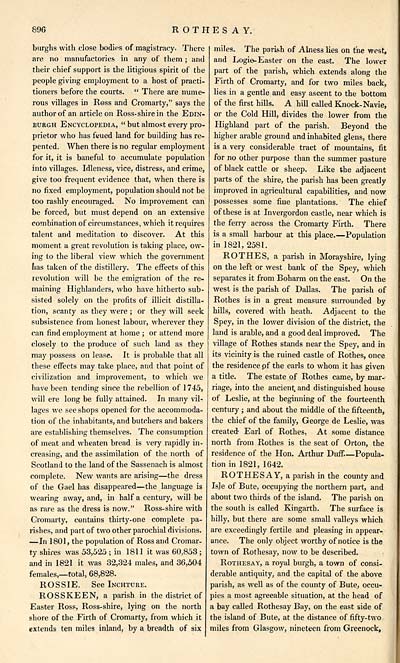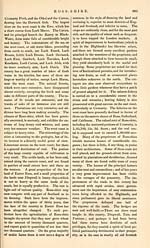Gazetteer of Scotland > Volume 2
(416) Page 896 - ROS
Download files
Complete book:
Individual page:
Thumbnail gallery: Grid view | List view

89G
ROTHESAY.
burghs with close bodies of magistracy. There
are no manufactories in any of them ; and
their chief support is the litigious spirit of the
people giving employment to a host of practi-
tioners before the courts. " There are nume-
rous villages in Ross and Cromarty," says the
author of an article on Ross-shire in the Edin-
burgh Encyclopedia, " but almost every pro-
prietor who has ftmed land for building has re-
pented. When there is no regular employment
for it, it is baneful to accumulate population
into villages. Idleness, vice, distress, and crime,
give too frequent evidence that, when there is
no fixed employment, population should not be
too rashly encouraged. No improvement can
be forced, but must depend on an extensive
combination of circumstances, which it requires
talent and meditation to discover. At this
moment a great revolution is taking place, ow-
ing to the liberal view which the government
has taken of the distillery. The effects of this
revolution will be the emigration of the re-
maining Highlanders, who have hitherto sub-
sisted solely on the profits of illicit distilla-
tion, scanty as they were ; or they will seek
subsistence from honest labour, wherever they
can find employment at home ; or attend more
closely to the produce of such land as they
may possess on lease. It is probable that all
these effects may take place, and that point of
civilization and improvement, to which we
have been tending since the rebellion of 1745,
will ere long be fully attained. In many vil-
lages we see shops opened for the accommoda-
tion of the inhabitants, and butchers and bakers
are establishing themselves. The consumption
of meat and wheaten bread is very rapidly in-
creasing, and the assimilation of the north of
Scotland to the land of the Sassenach is almost
complete. New wants are arising — the dress
of the Gael has disappeared — the language is
wearing away, and, in half a century, will be
as rare as the dress is now." Ross-shire with
Cromarty, contains thirty-one complete pa-
rishes, and part of two other parochial divisions.
— In 1801, the population of Ross and Cromar-
ty shires was 53,525 ; in 1811 it was 60,853 ;
and in 1821 it was 32,324 males, and 36,504
females,— total, 68,828.
ROSSIE. See Inchture.
ROSSKEEN, a parish in the district of
Easter Ross, Ross-shire, lying on the north
shore of the Firth of Cromarty, from which it
extends ten miles inland, by a breadth of six
miles. The parish of Alness lies on the west,
and Logie- Easter on the east. The lower
part of the parish, which extends along the
Firth of Cromarty, and for two miles back,
lies in a gentle and easy ascent to the bottom
of the first hills, A hill called Knock- Navie,
or the Cold Hill, divides the lower from the
Highland part of the parish. Beyond the
higher arable ground and inhabited glens, there
is a very considerable tract of mountains, fit
for no other purpose than the summer pasture
of black cattle or sheep. Like the adjacent
parts of the shire, the parish has been greatly
improved in agricultural capabilities, and now
possesses some fine plantations. The chief
of these is at Invergordon castle, near which is
the ferry across the Cromarty Firth. There
is a small harbour at this place. — Population
in 1821,2581.
ROTHES, a parish in Morayshire, lying
on the left or west bank of the Spey, which
separates it from Boharm on the east. On the
west is the parish of Dallas. The parish of
Rothes is in a great measure surrounded by
hills, covered with heath. Adjacent to the
Spey, in the lower division of the district, the
land is arable, and a good deal improved. The
village of Rothes stands near the Spey, and in
its vicinity is the ruined castle of Rothes, once
the residence pf the earls to whom it has given
a title. The estate of Rothes came, by mar-
riage, into the ancient, and distinguished house
of Leslie, at the beginning of the fourteenth
century ; and about the middle of the fifteenth,
the chief of the family, George de Leslie, was
created Earl of Rothes, At some distance
north from Rothes is the seat of Orton, the
residence of the Hon. Arthur Duff. — Popula-
tion in 1821, 1642.
ROTHESAY, a parish in the county and
Isje of Bute, occupying the northern part, and
about two thirds of the island. The parish on
the south is called Kingarth. The surface is
hilly, but there are some small valleys which
are exceedingly fertile and pleasing in appear-
ance. The only object worthy of notice is the
town of Rothesay, now to be described.
Rothesay, a royal burgh, a town of consi-
derable antiquity, and the capital of the above
parish, as well as of the county of Bute, occu-
pies a most agreeable situation, at the head of
a bay called Rothesay Bay, on the east side of
the island of Bute, at the distance of fifty-two
miles from Glasgow, nineteen from Greenock,
ROTHESAY.
burghs with close bodies of magistracy. There
are no manufactories in any of them ; and
their chief support is the litigious spirit of the
people giving employment to a host of practi-
tioners before the courts. " There are nume-
rous villages in Ross and Cromarty," says the
author of an article on Ross-shire in the Edin-
burgh Encyclopedia, " but almost every pro-
prietor who has ftmed land for building has re-
pented. When there is no regular employment
for it, it is baneful to accumulate population
into villages. Idleness, vice, distress, and crime,
give too frequent evidence that, when there is
no fixed employment, population should not be
too rashly encouraged. No improvement can
be forced, but must depend on an extensive
combination of circumstances, which it requires
talent and meditation to discover. At this
moment a great revolution is taking place, ow-
ing to the liberal view which the government
has taken of the distillery. The effects of this
revolution will be the emigration of the re-
maining Highlanders, who have hitherto sub-
sisted solely on the profits of illicit distilla-
tion, scanty as they were ; or they will seek
subsistence from honest labour, wherever they
can find employment at home ; or attend more
closely to the produce of such land as they
may possess on lease. It is probable that all
these effects may take place, and that point of
civilization and improvement, to which we
have been tending since the rebellion of 1745,
will ere long be fully attained. In many vil-
lages we see shops opened for the accommoda-
tion of the inhabitants, and butchers and bakers
are establishing themselves. The consumption
of meat and wheaten bread is very rapidly in-
creasing, and the assimilation of the north of
Scotland to the land of the Sassenach is almost
complete. New wants are arising — the dress
of the Gael has disappeared — the language is
wearing away, and, in half a century, will be
as rare as the dress is now." Ross-shire with
Cromarty, contains thirty-one complete pa-
rishes, and part of two other parochial divisions.
— In 1801, the population of Ross and Cromar-
ty shires was 53,525 ; in 1811 it was 60,853 ;
and in 1821 it was 32,324 males, and 36,504
females,— total, 68,828.
ROSSIE. See Inchture.
ROSSKEEN, a parish in the district of
Easter Ross, Ross-shire, lying on the north
shore of the Firth of Cromarty, from which it
extends ten miles inland, by a breadth of six
miles. The parish of Alness lies on the west,
and Logie- Easter on the east. The lower
part of the parish, which extends along the
Firth of Cromarty, and for two miles back,
lies in a gentle and easy ascent to the bottom
of the first hills, A hill called Knock- Navie,
or the Cold Hill, divides the lower from the
Highland part of the parish. Beyond the
higher arable ground and inhabited glens, there
is a very considerable tract of mountains, fit
for no other purpose than the summer pasture
of black cattle or sheep. Like the adjacent
parts of the shire, the parish has been greatly
improved in agricultural capabilities, and now
possesses some fine plantations. The chief
of these is at Invergordon castle, near which is
the ferry across the Cromarty Firth. There
is a small harbour at this place. — Population
in 1821,2581.
ROTHES, a parish in Morayshire, lying
on the left or west bank of the Spey, which
separates it from Boharm on the east. On the
west is the parish of Dallas. The parish of
Rothes is in a great measure surrounded by
hills, covered with heath. Adjacent to the
Spey, in the lower division of the district, the
land is arable, and a good deal improved. The
village of Rothes stands near the Spey, and in
its vicinity is the ruined castle of Rothes, once
the residence pf the earls to whom it has given
a title. The estate of Rothes came, by mar-
riage, into the ancient, and distinguished house
of Leslie, at the beginning of the fourteenth
century ; and about the middle of the fifteenth,
the chief of the family, George de Leslie, was
created Earl of Rothes, At some distance
north from Rothes is the seat of Orton, the
residence of the Hon. Arthur Duff. — Popula-
tion in 1821, 1642.
ROTHESAY, a parish in the county and
Isje of Bute, occupying the northern part, and
about two thirds of the island. The parish on
the south is called Kingarth. The surface is
hilly, but there are some small valleys which
are exceedingly fertile and pleasing in appear-
ance. The only object worthy of notice is the
town of Rothesay, now to be described.
Rothesay, a royal burgh, a town of consi-
derable antiquity, and the capital of the above
parish, as well as of the county of Bute, occu-
pies a most agreeable situation, at the head of
a bay called Rothesay Bay, on the east side of
the island of Bute, at the distance of fifty-two
miles from Glasgow, nineteen from Greenock,
Set display mode to: Large image | Transcription
Images and transcriptions on this page, including medium image downloads, may be used under the Creative Commons Attribution 4.0 International Licence unless otherwise stated. ![]()
| Gazetteers of Scotland, 1803-1901 > Gazetteer of Scotland > Volume 2 > (416) Page 896 - ROS |
|---|
| Permanent URL | https://digital.nls.uk/97435814 |
|---|
| Description | Volume II: Glenbanchor to Zetland. |
|---|---|
| Attribution and copyright: |
|
| Description | By Robert Chambers and William Chambers. Glasgow: Blackie & Son, 1838. 2 volumes. |
|---|---|
| Shelfmark | NF.1461.g.7 |
| Additional NLS resources: | |

